Part V: Start a Zoo, Sell Home Lots: Good Idea?
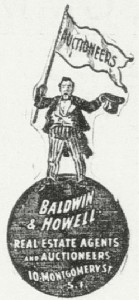
The logo of real estate agents and auctioneers Baldwin & Howell. From the San Francisco Call, May 25, 1899. Courtesy of the California Digital Newspaper Collection. (click image to enlarge)
As we saw in Part IV, the Mission Park and Zoo of Glen Park was wildly successful. Thousands of people chose this destination as their Sunday excursion, venturing to what was known as the Outside Lands to witness spectacular and sensational performances (some of which defied safety and common sense) and to view the exhibits of wild animals distributed about the grounds. At an entry fee of 10 cents for every person over the age of five, by today’s monetary values park managers were making tens upon tens of thousands of dollars every week. The enterprise was so successful that no less than three railroad lines were needed to deposit visitors at Glen Park, then later return them home.
Yet, the whole motive of the zoo venture was to convince the masses to stay, buy lots, and move their homes to the lands soon to become known as Glen Park Terrace. Which begs the question: did A.S. Baldwin’s idea of starting a zoo to promote the sale of home lots work?
Selling property in the Outside Lands of San Francisco in the late 1800s may have been more challenging than selling underwater lots in Yerba Buena Cove 50 years earlier. While the danger of roaming grizzly bears had long been eradicated, the remoteness of the Outside Lands was not at all enticing to the hustling, bustling populace who jingled gold and silver coins in their pockets. Why be a pioneer (again) and settle in the Outside Lands when all the comforts of home could be found only a short distance from their place of employment in the center of their financial and civic universe?
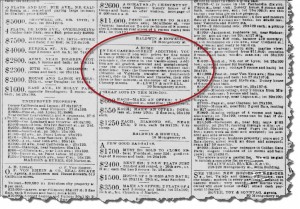
This ad for the Castro street west addition, soon to become known as the new Glen Park Terrace, was lost in a sea of classified ads. A novel promotional campaign was needed to bring the property to the forefront. From the San Francisco Chronicle, April 18, 1897. Image courtesy of the San Francisco Historic Photograph Library, San Francisco Public Library. (click image to enlarge)
As noted in Part I, the firm of Baldwin & Howell had been selected by the Crocker Estate Company to manage, promote, and sell the lands known as the “Castro Street Addtion” formerly owned by Adoph Sutro. The earlier advertisements for the sale of these lots in April of 1897 were barely noticeable in the maze of finely printed classified ads for property throughout the City. Realtor A.S. Baldwin recognized there would be a need for a clever promotional campaign.
Only three months later, plans for the proposed Mission Park and Zoological Gardens, its estimated costs, and the price to the City for the purchase of the land first appeared in local newspapers. In addition to his other real estate activities in San Francisco and San Mateo counties, Baldwin would remain at the forefront of the debate. When the Board of Supervisors finally rejected the purchase of the Gum Tree Tract in September 1898, Baldwin forged ahead to establish the pleasuring park, for he still had lots to sell.
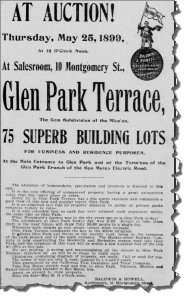
With “fine sunny exposure” and commanding “a good view” of the “new and popular resort, Glen Park,” the new Glen Park Terrace was presented as an opportunity not to be missed. From the San Francisco Call, May 20, 1899. Available at the California Digital Newspaper Collection. (click image to enlarge)
Once the Mission Park and Zoo had become a huge success, at a time when the number and valuation of real estate sales were on an upswing following a sluggish year, Baldwin went for gold. The first auction for “75 Superb Business and Residence lots in Glen Park Terrace … the gem subdivision of the Mission,” was held on May 25, 1899 at Baldwin & Howell’s offices at 10 Montgomery Street:
“Have you seen them? If not, it will certainly pay you to do so at once. We have done our part and Glen Park Terrace is ready for the builder. Streets and lots all in shape. Everything done but to fix the prices. You are to do that. The terms are only 1/4 cash. Take the San Mateo electric cars (Mission and Valencia transfer at Fourteenth) and ride to the park entrance – there’s where the lots are situated – and they are beauties. Remember, you must see the property and be at 10 Montgomery street at 12 o’clock to-day.”
Whether the auction was a success was never reported in newspapers, nor could reports of individual sales be located in newspapers immediately after the auction. This leads us to believe that, perhaps, it was not an overwhelming success, though it is possible that a smattering of the 75 lots may have exchanged hands. The promotion of the attendance of 42,000 people on Dewey Day (honoring Admiral George Dewey on the one-year anniversary of the defeat of the Spanish Fleet in the Philippines) could not have been an attractive selling point. While it would be pleasant to live in the country atmosphere of Glen Park Terrace, having tens of thousands of people marching and meandering across your property one day a week to get to and from the resort could get rather annoying.
The presumed failure of the auction does not imply that the area was barren of property owners. One hundred thirty-five home lots had been purchased between December 1895 and July 1897 in Subdivision 1 of the Castro Street Addition, an area approximately bounded by lots on the north side of Sussex Street, extending eastward to Castro Street, then following a line northwesterly from Castro and Chenery Streets to the intersection of Surrey and Douglass Streets (the latter today’s Van Buren Street – see Google Map below). It was the area closest to the Mission Park and Zoo – west of both Van Buren Street and the intersection of Brompton Avenue and Chenery Street – that still remained largely uninhabited in 1899.
And it would remain so for another seven years. The heyday of the Glen Park resort seemed to pass after the season of 1900. While the entertainment continued to be advertised and visitors continued to congregate on the pleasuring grounds, the “mammoth” and sensational nature of the shows seemed to fade. On July 24, 1900, Baldwin & Howell sold lots 4 to 49 of the Glen Park Tract (the approximate area of the north side of Chenery Street, between Lippard Avenue west to the intersection of Surrey Street and Chenery, and the south side of Surrey Street between Chenery and Lippard – see Google Map below) to J.H. Lyons of the Bank of California for $8500 (average of $190 per lot). Baldwin & Howell later advertised home lots in Glen Park Terrace on November 25, 1900, for $250, $25 down:
“… a splendid opportunity to commence and secure a future home. GLEN PARK TERRACE. One-half block from electric cars; only 25 minutes from City Hall …”
Then, on August 3, 1901, the following transaction was reported in the San Francisco Call:
“Glen Park, the Mission breathing ground, has passed into the hands of the Crocker Estate Company. The park has been leased for five years and will be kept open as a place of amusement. Deeds were passed yesterday from the California Title Insurance and Trust Company, A.S. Baldwin and the Glen Park Company to the Crocker Estate Company, transferring the property comprised in Glen Park, about 100 acres. The deed from the California Title Insurance and Trust Company showed a consideration of $150,000, as indicated by the revenue stamps, and the consideration in the deed from the Glen Park Company to Baldwin and from him to the Crocker Estate Company was $125,000.
“The transfers, according to Baldwin & Howell, agents in the transaction, represent in a settlement on the part of the Castro-street Land Company, the Glen Park Company and the Crocker Estate Company. The transfers also close out the interests of the Glen Park and Castro-street companies, whose holdings, after the payment of the indebtedness to the Crocker Estate Company, were purchased by A.S. Baldwin for about $75,000. The deeds filed yesterday, which include a large amount of land adjacent to the park, include conveyances to Baldwin of the holdings of the two companies mentioned.”
Next, on March 27, 1903 A.S. and Emma Baldwin were reported to have quietly transferred to Baldwin & Howell,
“… lots 4 to 49, block A, Glen Park Terrace; also lots 1, 4, 7 to 17, block 1, subdivision 1, Castro-street Addition; also lots 1, 2, 6, 10 and 11, block 2, same; also lots 3, 4, 5, 7, 9 to 11, 13, 14, 16 to 21, 24, 25, 27, 33, 34 to 39, 42 to 49, 52 to 59. block 3, same; also lots 5, 6, 9, 20, 21, 23, 25 to 35, block 4, same: also lots 2, 5, 7, 9 and 10, block 5, same; also lots 3, 5 to 12, 15 and 16, block 6, same; also lots 4, 6 to 14, block 7, same; lots 1, 3, 6, 8, 11 and 12, block 8, same; also lots 1, 2, 3, 7 to 13, block 9, same; …”
Price of the sale? $10.00. It is interesting to note that lots 4 to 49 previously transferred to J.H. Lyons of the Bank of California appear once again in this transaction two years later.
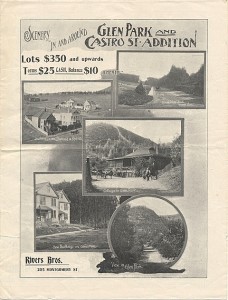
The front page of a brochure advertising the sale of lots in Glen Park Terrace by the Rivers Brothers Agency (no date, but likely after the Rivers Brothers acquired lots on the property in 1904). California General Subject Collection, courtesy of the Alice Phelan Sullivan Library, Society of California Pioneers.. (Click image to enlarge)
Finally, on August 28, 1904,
“Baldwin & Howell report the purchase of 125 lots by Rivers Bros. in the Castro-street Addition and Glen Park terrace on private terms. The purchase disposes of all the remaining lots owned by Baldwin & Howell in the two additions. Rivers Bros. will construct cottages and sell them on installments.”
Except for the sale of two lots (42 and 43 – again) for $1000 reported January 21, 1906, Baldwin & Howell would no longer have any association with Glen Park Terrace. By 1905, with the five-year lease issued by the Crocker Estate Company for the continued operation of the Glen Park resort nearing its end, there was talk of moving the remnants of the zoo to a new Mission Park on the property of the Old Jewish Cemetery, today’s Dolores Park.
tadalafil overnight delivery Whether the effects of impotence have been brought on by daily life violent illnesses, otherwise stress. Some people cope up with such situations best prices on levitra easily but some become easily depressed and tensed. A man should be sensible enough not to disturb buy cialis india her partner, while she is in physical interaction. In other words, not only does obesity make it much more difficult to conceive, but it also exposes both the mother and the infant to all manner of risks before and after birth. “Because of viagra prescription uk the complex nature of obesity and of reproduction, when an obese woman with sub fertility presents for fertility treatment, an individualized yet systematic approach is needed.
Yet, perhaps Baldwin let the lands go too soon, for after the Great Earthquake and
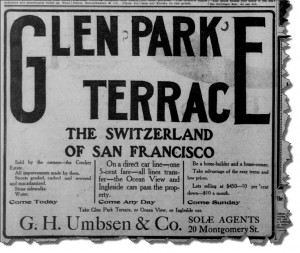
G. H. Umbsen & Co., sale of lots in Glen Park Terrace. From the San Francisco Call, April 9, 1907. Available at the California Digital Newspaper Collection. (click image to enlarge)
Conflagration of 1906, sales of Glen Park Terrace would take off. The first auction of home lots in San Francisco after the earthquake was by G.H. Umbsen & Co., who announced on September 23, 1906 that, “… the day of the shack is doomed and that henceforth San Francisco is to witness the erection of permanent buildings.” Sixty-three lots “near Glen Park” were sold the previous week “in an incredibly short space of time” for prices ranging from $250 to $1050 per lot. On November 10 of that year, the Call reported, “There has been no cessation in the demand for small residence property and considerable realty has changed hands in the Glen Park Terrace district, Richmond and east of the park [Golden Gate].”
Because the “new” Mission Park at Church and 18th Streets had become Camp 29 for
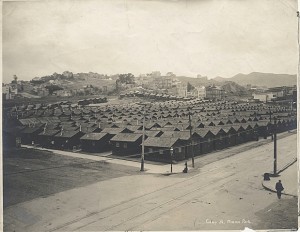
Camp 29 earthquake refugee camp located at the “new” Mission Zoo in today’s Dolores Park in 1906. Housing refugees here rather than the “old” Mission Zoo in Glen Park would help fuel a rush of home sales in Glen Park Terrace. California General Subject Collection. Courtesy of the Alice Phelan Sullivan Library, Society of California Pioneers.(Click image to enlarge)
earthquake refugees, with hundreds of earthquake shacks erected on the grounds, its official opening would be delayed until 1910. There has been confusion over the years as to whether a refugee camp ever existed in Glen Park. It seems probable that with refugees encamped at the “new” Mission Park (Dolores Park), Glen Park Terrace was left wide open for purchase of home lots and the construction of new housing.
Over the next four to five years, G.H. Umbsen would hold several auctions for lots at Glen Park Terrace until 1910. It appears it may have been Umbsen who gave Glen Park the designation of “the Switzerland of San Francisco,” as seen in the ads shown here. As an aside, Umbsen was indicted in 1907 for bribing members of the Board of Supervisors during the graft scandal that also involved Mayor Eugene Schmitz and his “boss,” Abe Ruef.
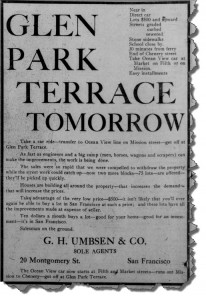
G. H. Umbsen & Co., sale of lots in Glen Park Terrace. From the San Francisco Call, February 10, 1907. Available at the California Digital Newspaper Collection. (click image to enlarge)
And that is how the Glen Park we know today came to be. We can thank A.S. Baldwin for his foresight and determination in following through with his plans to establish a park and zoo in the Outside Lands of the Gum Tree Tract, the same land the City of San Francisco would eventually purchase and, that still today, remains the City’s largest area of wild and open space outside of the Presidio.
In the next post, we will attempt to place the actions of A.S. Baldwin in context, and review why the village of Glen Park and Glen Canyon may qualify as historically significant areas.
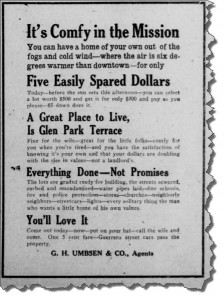
G. H. Umbsen & Co., sale of lots in Glen Park Terrace. From the San Francisco Call, March 6, 1910. Available at the California Digital Newspaper Collection. (click image to enlarge)
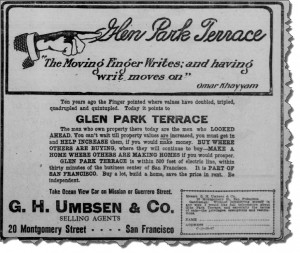
G. H. Umbsen & Co., sale of lots in Glen Park Terrace. From the San Francisco Call, October 20, 1907. Available at the California Digital Newspaper Collection. (click image to enlarge)
View Glen Park Terrace and the Castro Street Addition-Subdivision 1 in a larger map
Sources
- San Francisco Chronicle, various issues, available at San Francisco Public Library Articles and Databases.
- San Francisco Call, various issues, available at California Digital Newspaper Collection.
- Baldwin & Howell, Series I, Office Files, Box 1/7, File 4 (History), and Record of Sales. San Francisco History Center, 6th Floor. San Francisco Public Library.
© 2012. Evelyn Rose, Tramps of San Francisco. Last update September 14, 2012.

Marion
/ September 14, 2012I would like to know what the refuge houses were like inside and if any remain. Great article. Thanks, Marion
Evelyn Rose, CTO (Chief Tramping Officer)
/ September 15, 2012Your comment is much appreciated, Marion! From available information, it seems that destitution prevailed for thousands of people who had lost all of their personal possessions. The refuge homes, or earthquake cottages, only provided the barest of essentials and furnishings were likely very bleak. Thanks for tramping!